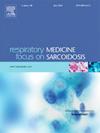治疗肺动脉高压的 Riociguat:4-strata COMPERA 2.0 风险评估工具在 PATENT 研究中的应用。
IF 3.5
3区 医学
Q2 CARDIAC & CARDIOVASCULAR SYSTEMS
引用次数: 0
摘要
背景:风险分层是评估肺动脉高压(PAH)患者疾病严重程度的重要部分。本研究将 4 层 COMPERA 2.0 风险模型应用于利奥西瓜特的 3 期 PATENT-1/2 研究:这是对 PATENT-1 和 PATENT-2 的事后分析。对PATENT-1基线和第12周的风险分层进行了Kaplan-Meier曲线的对数秩检验,以比较PATENT-2人群的临床恶化时间和2年生存率:214名服用利奥吉曲特的患者和100名服用安慰剂的患者在基线时的COMPERA 2.0状态数据可用;总体而言,120名患者被确定为中低风险,96名患者被确定为中高风险。在PATENT-1第12周,COMPERA 2.0风险分层和6分钟步行距离中位数方面,使用利奥吉曲特与安慰剂相比,基线时被COMPERA 2.0评估为中低风险和中高风险的患者均有所改善。在中低风险组(38% 对 22%)和中高风险组(42% 对 31%)中,使用利奥吉曲特与安慰剂相比,有更多患者的 COMPERA 2.0 风险状况有所改善。在PATENT-1基线和第12周评估的COMPERA 2.0对PATENT-2中2年生存和临床恶化的风险分层具有区分作用(所有分析的P≤.001):总之,该分析支持利奥吉曲特对中低风险和中高风险的 PAH 患者具有降低风险的益处,并从外部验证了 COMPERA 2.0 在临床试验人群患者长期风险评估中的实用性。本文章由计算机程序翻译,如有差异,请以英文原文为准。

Riociguat in pulmonary arterial hypertension: Application of the 4-strata COMPERA 2.0 risk assessment tool in the PATENT studies
Background
Risk stratification is an essential part of evaluating disease severity in patients with pulmonary arterial hypertension (PAH). This study applied the 4-strata COMPERA 2.0 risk model to the Phase 3 PATENT-1/2 studies of riociguat.
Methods
This was a post hoc analysis of PATENT-1 and PATENT-2. Log-rank tests of Kaplan–Meier curves were performed to compare the risk strata at PATENT-1 baseline and Week 12 regarding time to clinical worsening and survival at 2 years in the PATENT-2 population.
Results
Data on COMPERA 2.0 status at baseline were available for 214 patients with riociguat and 100 with placebo; overall, 120 patients were identified as intermediate-low risk and 96 as intermediate-high risk. At PATENT-1 Week 12, improvements in COMPERA 2.0 risk strata and median 6-min walk distance were seen with riociguat vs placebo in patients assessed as intermediate-low risk and intermediate-high risk at baseline by COMPERA 2.0. More patients improved their COMPERA 2.0 risk status with riociguat vs placebo in the intermediate-low (38 % vs 22 %) and intermediate-high risk groups (42 % vs 31 %). COMPERA 2.0 assessed at PATENT-1 baseline and Week 12 discriminated between risk strata for survival and clinical worsening in PATENT-2 at 2 years (p ≤ .001 for all analyses).
Conclusions
In conclusion, this analysis supports the risk-reduction benefits of riociguat in patients with PAH at intermediate-low risk and intermediate-high risk, and externally validated the utility of COMPERA 2.0 in the long-term risk assessment of patients from a clinical trial population.
求助全文
通过发布文献求助,成功后即可免费获取论文全文。
去求助
来源期刊

Respiratory medicine
医学-呼吸系统
CiteScore
7.50
自引率
0.00%
发文量
199
审稿时长
38 days
期刊介绍:
Respiratory Medicine is an internationally-renowned journal devoted to the rapid publication of clinically-relevant respiratory medicine research. It combines cutting-edge original research with state-of-the-art reviews dealing with all aspects of respiratory diseases and therapeutic interventions. Topics include adult and paediatric medicine, epidemiology, immunology and cell biology, physiology, occupational disorders, and the role of allergens and pollutants.
Respiratory Medicine is increasingly the journal of choice for publication of phased trial work, commenting on effectiveness, dosage and methods of action.
 求助内容:
求助内容: 应助结果提醒方式:
应助结果提醒方式:


